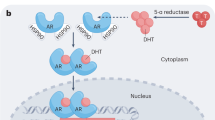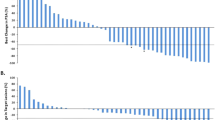Abstract
In most clinical trials of intermittent androgen deprivation (IAD), the decision to stop androgen withdrawal is based on monitoring PSA levels, waiting for its drop to nadir. Based on in vitro pre-clinical studies, a modified ‘on–off’ schedule of short intervals of androgen deprivation, designated pulsed androgen deprivation (PAD), is proposed to destroy androgen dependent (AD) cells more gradually and to conserve their androgen-independent (AI) inhibitory potential for longer periods, resulting in an overall prolongation of time to hormone resistant progression.
This is a preview of subscription content, access via your institution
Access options
Subscribe to this journal
Receive 4 print issues and online access
$259.00 per year
only $64.75 per issue
Buy this article
- Purchase on Springer Link
- Instant access to full article PDF
Prices may be subject to local taxes which are calculated during checkout
Similar content being viewed by others

Author information
Authors and Affiliations
Rights and permissions
About this article
Cite this article
Pantuck, A., Zismon, A., Tso, CL. et al. Intermittent androgen deprivation therapy: schedule modifications based on a novel in vivo human xenograft model. Prostate Cancer Prostatic Dis 3, 280–282 (2000). https://doi.org/10.1038/sj.pcan.4500473
Received:
Accepted:
Published:
Issue Date:
DOI: https://doi.org/10.1038/sj.pcan.4500473


